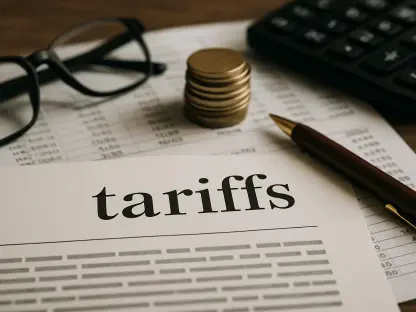By 2025, the U.S. financial landscape has been marked by transformative tax reforms, Federal Reserve leadership shifts, and mounting federal debt. These elements are interconnected, casting a long shadow over investment strategies and economic growth. This landscape requires investors to adapt swiftly, as fiscal policies by Secretary Scott Bessent attempt to address both opportunities and risks in the marketplace. His “One Big Beautiful Bill Act,” aimed at making 2017’s tax cuts permanent, intensifying manufacturing incentives, and modernizing the IRS, stands central to current developments. Interestingly, while these changes promise substantial short-term economic growth, they also cause rising concerns about fiscal stability.
Tax Reforms and Investment Opportunities
Impact on Growth Sectors
The 2025 fiscal policies introduced by Scott Bessent have focused on reinvigorating key sectors through the powerful vehicle of tax incentives. Manufacturing and technology sectors stand to gain significantly from these reforms due to enhanced incentives. The combined impact of tax relief and growth in technology-driven sectors paints a beneficent picture for certain parts of the economy. As tax benefits potentially turbocharge these industries, they pose lucrative opportunities for investors willing to bet on American innovation and production capacity. However, this is not without its challenges. Skeptics argue that these benefits may not be evenly distributed across sectors, emphasizing the importance of a strategic selection in portfolio management.
The reforms also aim to preserve and bolster domestic manufacturing capabilities by attracting both local and international investments into the sector. Such a shift aligns well with globalization trends, positioning the U.S. as a competitive player in the global market. However, an over-reliance on such incentives could produce an unbalanced fiscal policy, risking sustainability. While offering fresh investment opportunities, they may result in a fiscal dearth long term if not coupled with rigorous fiscal management. Investors need to keenly observe these dynamics to seize opportunities while avoiding potential pitfalls in a rapidly shifting economic environment.
Challenges for High-Debt Sectors
Not all industry players benefit equally, with high-debt issuers like utilities and real estate potentially facing significant headwinds. With the constant shadow of interest rate hikes looming, the viability of these sectors remains questionable in the face of burgeoning fiscal changes. Potential increases in borrowing costs threaten existing profit margins, casting doubt on their attractiveness to investors. Companies in these sectors must judiciously manage debt while balancing expansion and sustainability to secure a stable position in volatile markets.
As fiscal and monetary policy may diverge, sectors accustomed to high-debt financing must adopt conservative strategies to navigate potential interest rate hikes. Because these sectors rely heavily on financing for growth and stability, caution dictates strategic planning over aggressive investment. Stakeholders must monitor how policymakers juggle interest rates with fiscal discipline to preemptively adjust their strategies, balancing growth aspirations against financial realities. These hurdles command attention from those skeptical of Bessent’s broader deficit target despite his promises of curtailing it via economic growth by 2028.
Federal Reserve Shifts and Market Dynamics
Navigating Monetary Policy Changes
The transition in Federal Reserve leadership adds a layer of complexity to the existing fiscal scene. With candidates poised for aggressive rate cuts, investors face new dilemmas tied to the Fed’s potential loss of independence and its responsiveness to political pressure. This climate introduces uncertainties concerning authorities’ balancing of fiscal priorities against monetary imperatives. While on one hand, lower borrowing costs may sustain short-term growth, it raises questions on sustainability and the long-term outlook.
In light of these changes, financial markets are predicted to undergo significant fluctuations, reflecting sentiment adjustments in reaction to leadership’s clarity, or lack thereof. Banking and government bond markets, in particular, are directly impacted by potential shifts in regulatory frameworks and policy alignment. The uncertainties steer nervousness and volatility, making it critical for investors to place a premium on resilience and agility. By anticipating a spectrum of market responses to leadership moves, stakeholders can buffer against negative developments and capitalize on informed opportunities.
Response Strategies for Investors
Investors are urged to scrutinize their portfolios’ offensiveness and defensiveness, ensuring adequate traction amid potential volatility resulting from fiscal-monetary policy tensions. A tilt towards cyclical sectors could deliver plentiful rewards, provided fiscal stimuli roll out effectively. Meanwhile, avoiding or hedging against vulnerabilities in high-debt issuers furnishes additional assurances of resilient performance in a strained environment. This includes utilities and real estate sectors that could face rising borrowing costs, constraining growth unless innovative solutions are deployed.
Exploring defensive assets, including gold and other treasury-sensitive sectors, might help mitigate risks as fiscal priorities interfuse with monetary adjustments. By cautiously analyzing both facets—aligning with fiscal stimuli where viable and hedging against fiscal policy missteps—investors can strategically position themselves amid evolving landscapes. The need for dynamic and proactive management of portfolios has never been more crucial, set against a backdrop of potential political and economic flux. Navigating these challenges is vital for maintaining equilibrium in a landscape where fiscal imperatives dovetail with complex intersectional markets.
Investing Amid Uncertainty and Challenges
By 2025, the U.S. financial landscape has undergone significant transformation due to tax reforms, shifts in leadership at the Federal Reserve, and an increasing federal debt. These elements are deeply intertwined and are significantly influencing investment strategies and overall economic growth. In this evolving environment, investors need to rapidly adjust their approaches, particularly as fiscal policies, under the guidance of Secretary Scott Bessent, aim to navigate both the opportunities and challenges present in the marketplace. Bessent has introduced the “One Big Beautiful Bill Act,” whose primary goal is to make the 2017 tax cuts permanent, boost incentives for manufacturing, and modernize the IRS. While these changes are expected to boost short-term economic growth substantially, they are also raising concerns about long-term fiscal stability. The combination of promising growth and fiscal uncertainty necessitates careful planning and strategy for investors looking to thrive in this new era of American economic policy.









